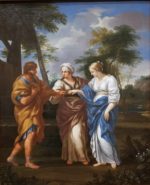Binary Universe III: Two Camps of Angels
This post continues the discussion we began in “Bereshit: The Binary Universe I” and continued in “The Binary Universe II: Angels as Microprocessors.” At the
This post continues the discussion we began in “Bereshit: The Binary Universe I” and continued in “The Binary Universe II: Angels as Microprocessors.” At the

Now Laban had two daughters: the name of the elder was Leah, and the name of the younger was Rachel. (Genesis 29:16) Rabbi Isaiah Horowitz (the

November 19, 2018 And he [Jacob] dreamed, and behold! a ladder set up on the ground and its top reached to heaven; and behold, angels

And he arrived upon the place and lodged there all night, because the sun was set; and he took from the stones of the place,

Synopsis This essay reads Jacob’s agreement with Laban over the streaked, speckled, and spotted sheep as far more than an odd detail in an ancient

Reading the Torah, sometimes, can give a false impression of reading a story, albeit the greatest story ever written. This Divine drama involves colorful characters,

The story of entangled twins is continuing in the Torah portion Vayeitzei (Genesis 28:10–32:3.) Structurally, it is very similar to the story in the previous Torah

And he dreamed, and behold! a ladder set up on the ground and its top reached to heaven; and behold, angels of G‑d were ascending